I don’t like guided meditations. Perhaps the only guided meditation I’ve actually enjoyed is this one sent to me by a friend. Most definitely Not Safe For Work.
Continue reading “Not safe for work”Category: Pop Culture
How to make Halloween costumes for your stuffies
If you can’t go out trick-or-treating this year, or go to a Halloween party, how about making costumes for your stuffed animals? You could even hold a costume party for stuffies. Here’s a video with some idea on how to make easy, effective costumes for your stuffed animals:
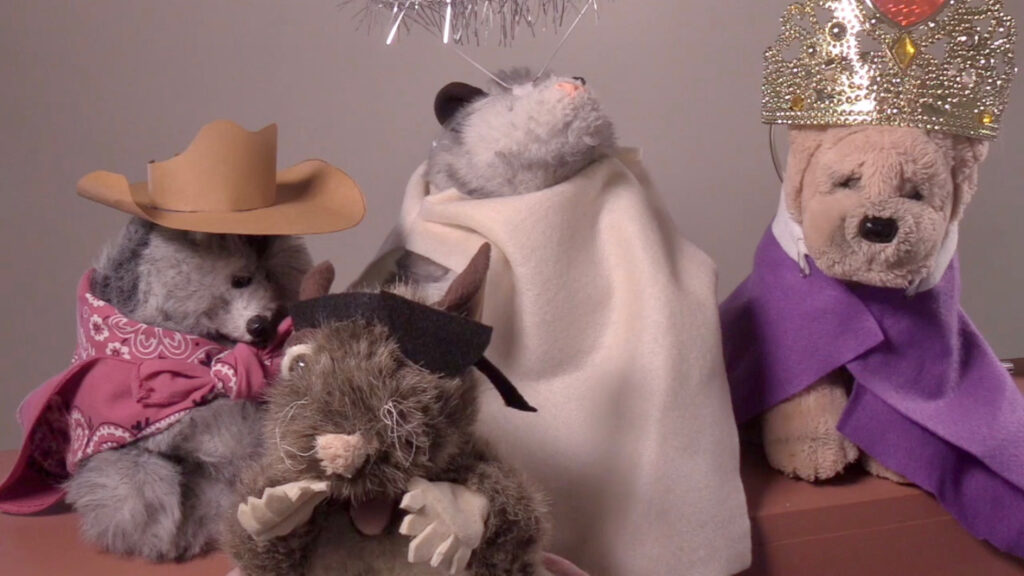
In the video, you’ll see Dr. Sharpie Ann get costumed as a queen (Queen of the Universe, of course), Packie the Dusky-footed Woodrat as a pirate, Possum as an angel, and Hedgehog as a cowboy.
Once you dress up your stuffies, take their photos and post them on social media.
Contestants on a Game Show! part 3
The third installment of the Contestants on a Game Show! series:
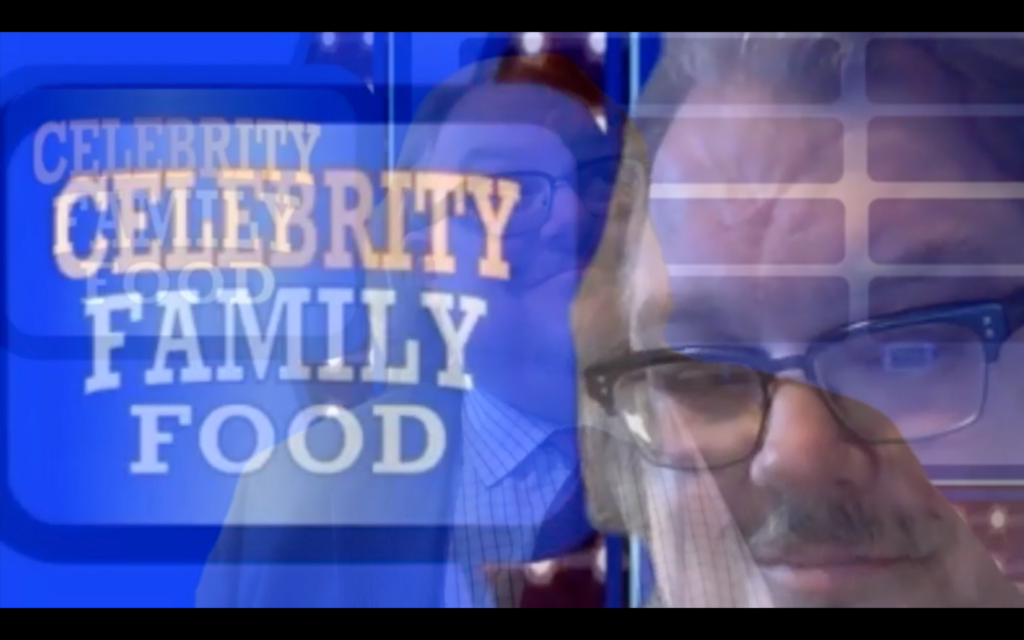
Contestants on a Game Show! part 2
The second installment of the Contestants on a Game Show! video series:
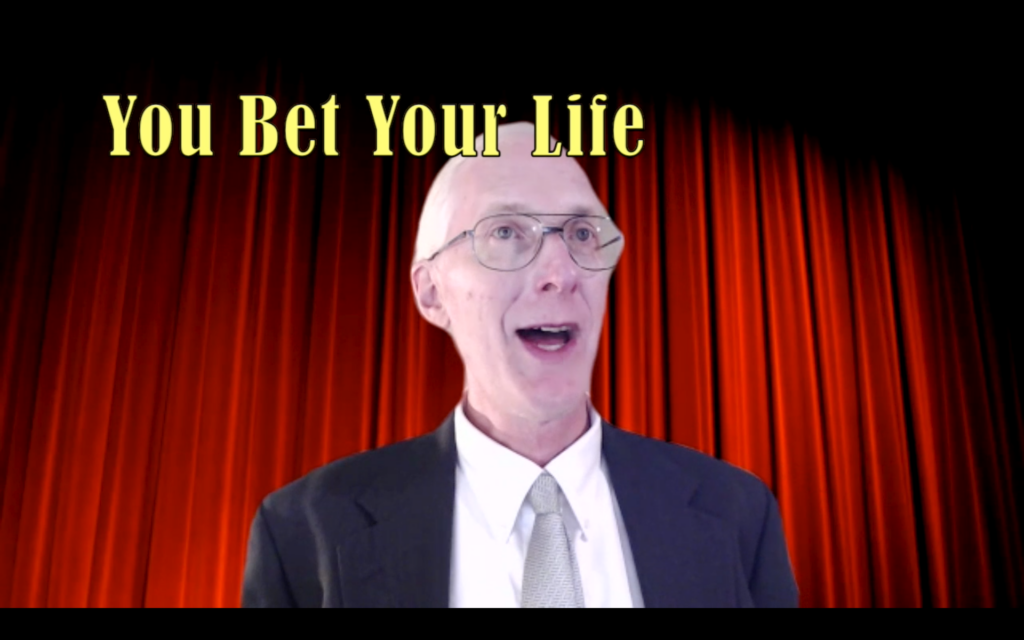
Contestants on a Game Show! part 1
The first installment of the Contestants on a Game Show! video series:

Adventures in mask making
As of April 2, the San Mateo County Board of Health recommends that everyone wear a mask when they’re in public places.
I’ve been doubtful about the efficacy of masks, since my understanding is that wearing a mask won’t do much to protect you from being infected by others. But I’ve come to understand that masks might protect others from being infected by you, if you happen to have COVID-19 but are still asymptomatic.
So today I decided to be a good citizen and sew a couple of masks, one for Carol and one for me. I am very slow at sewing, partly because I don’t know how to use a sewing machine, and partly because I don’t know what I’m doing. But I found a good online video showing how to make one of the 2-layer pleated masks that are supposed to be the most effective handmade masks. I didn’t have the elastic bands called for in the video, but I had some 1/4 inch polyester cord to use for the ties. Carol has a big bolt of unbleached cotton muslin, and I sacrificed an old t-shirt. Sewing the pleats by hand was kind of a pain at first, but I quickly figured it out.
After two or three hours, I had a mask for Carol and a mask for me. We went to the grocery store, and three quarters of the people there were also wearing masks. Mask wearing peer pressure has begun.
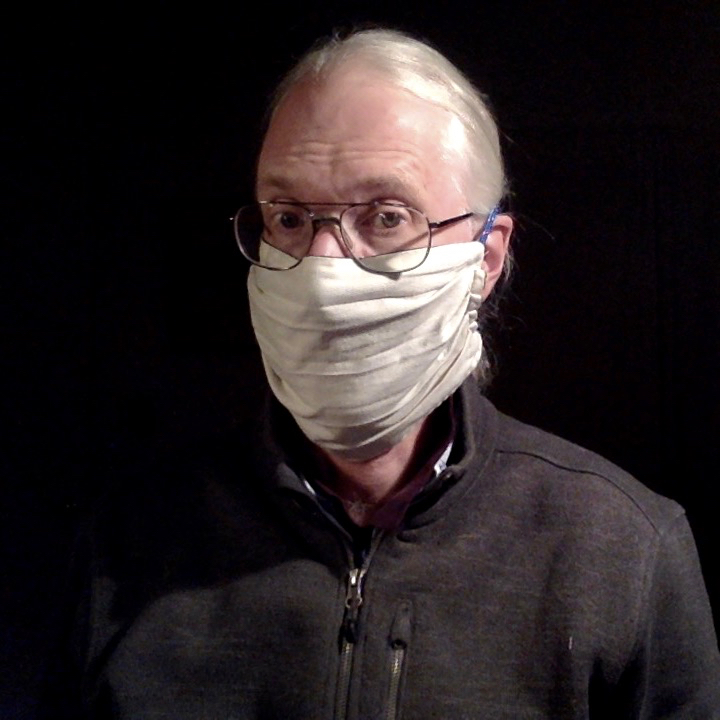
As soon as we got home, I washed both masks in hot water, as you’re supposed to do.
Next step: make another mask for Carol using a high fashion fabric for the outer layer….
The obligatory COVID-19 blog post
Any blogger worth their salt now has to write a post about the novel COVID-19 virus, popularly known as coronavirus. I want to talk about the recommendations for handwashing issued by the Center for Disease Control (CDC).
Now, the CDC is recommending that we wash our hands frequently to avoid spreading infection from COVID-19 and other infectious diseases like the flu. I’m fine with that. According to the CDC, proper handwashing technique involves five steps. I’m fine with that, too. But in Step 3, the CDC instructs us to sing the “Happy Birthday” song twice so we make sure we wash for a full 20 seconds.
Ugh. I hate the “Happy Birthday” song. I don’t want to sing it once, let alone twice, let alone every time I wash my hands.
Fortunately, I have an alternative. Ginger, a UU religious educator in the Bay Area, found this, which was posted in a bathroom of a UU congregation:
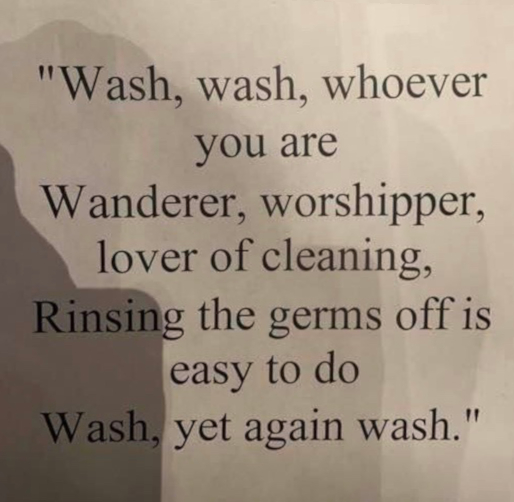
“Wash, wash, whoever you are,
Wanderer, worshipper, lover of cleaning,
Rinsing the germs off is easy to do
Wash, yet again, wash.”
(with presumed apologies to Rumi and Coleman Barks)
If you sing “Wash, wash, whoever you are…” to Lynn Ungar’s tune in the UU hymnal Singing the Living Tradition (no. 188), at a reasonably quick tempo (about 144 bpm), it takes about 16-17 seconds to sing. Then you can repeat “Wash, yet again, wash” to make a full 20 seconds. Much better than the “Happy Birthday” song.
And there are still more songs you (and/or your children) can use to time your handwashing.
More than a decade ago, Dr. Robert Piper, retired professor of political science at UMass Dartmouth, demonstrated how you can sing the ABC song to time your handwashing. Since I trust retired professors of political science, that’s what I’ve been doing ever since.
Or, if you want to be religious, there’s a passage from sacred scripture that neatly fits the tune of the ABC Song (which is, by the way, a lovely folk tune immortalized by Mozart in K. 265) — I’m referring of course to the Mad Hatter’s poem in the holy writ of Alice’s Adventures in Wonderland:
“Twinkle, twinkle, little bat!
How I wonder where you’re at!
Up above the world you fly,
Like a tea tray in the sky.
Twinkle, twinkle, little bat!
How I wonder where you’re at!
So you see, if you too hate the “Happy Birthday” song, you (and/or your children) now have 3 other options to time handwashing: “Wash, wash, whoever you are”; the ABC song; and “Twinkle, twinkle, little bat.”
Update: (1:12 p.m.) Ginger found yet another UU handwashing song online, which also lasts about 20 seconds:
“Come wash your hands with me
Come wash your hands with me
Come wash your hands with me,
So we can know peace of mind.
And I’ll bring you soap,
When soap is hard to find,
And I’ll wash my hands with you
So we can help humankind.”
What does it mean to be cisgender?
In article on Feminist Current, a Canadian Web site, Robert Jensen, a professor of journalism at the Univ. of Texas Austin, questions his assignment into the category of cisgender:
“…Sex is a question of biologically determined male and female, gender of socially determined masculinity and femininity. The dominant conception of masculinity in U.S. culture asserts that men are naturally competitive and aggressive, and that being a ‘real man’ means struggling for control, conquest, and domination. A man looks at the world, sees what he wants, and takes it. This is sometimes labeled ‘toxic masculinity,’ which implies it is an aberration from some ‘normal’ masculinity. But this understanding of masculinity-as-seeking-dominance is the default setting for most males growing up in patriarchy, especially through the glorification of aggression in the military, sports, and business.
“All that definitional work [Jensen continues] is necessary to explain why I am not cisgender. As a male human, this patriarchal conception of masculinity is not my ‘chosen’ identity, nor do I believe it is my fate. As a short, skinny, effeminate child … I never felt very masculine. As an adult with feminist politics, I reject and struggle to overcome the masculinity norms in patriarchy. If we were someday to transcend patriarchy, would I feel more ‘like a man’? That would depend on how the term was defined, but in the world in which I live, I refuse to embrace the patriarchal gender identity handed to me….
“So [Jensen concludes], I’m not cisgender and I’m not transgender. I am not gender fluid, non-binary, or multi-gender. I self-identify as an adult biological XY male who rejects patriarchal gender norms and works from a radical feminist perspective to eliminate patriarchy….”
While it has some problematic moments, I think Jensen’s essay offers a small but useful addition to the ongoing debate about the term “cisgender.” If you haven’t been following that debate, some have argued that “cisgender” is analogous to the introduction of “heterosexual” as the opposite of “homosexual”; similarly, “cisgender” can help non-trans people realize the extent to which they have the privilege of not having to articulate their gender; therefore it is a necessary term. Arguments against the term include the possibility that setting up such a strong distinction between transgender and cisgender may actually work against a widespread acceptance of transgender as normal; others claim that transgender and cisgender are Western cultural concepts that don’t apply cross-culturally (e.g., Native Americans who reject the identification of the Two-Spirit tradition with transgender).
What Jensen offers to this debate is his personal experience of gender. He does not see himself as typically masculine; therefore, he does not see that his biological sex matches society’s expectations about the gender role he should take on. Yet he does not consider himself transgender, either. There’s an argument to be made that Jensen has cisgender privilege because he’s non-trans, and thus the term is useful; however, I’m not convinced that biological men and boys who are not masculine, but also non-trans, get the same level of privilege as a stereotypically masculine biological male since (depending on how effeminate you are) a straight non-trans non-masculine man will tend to experience some level of bullying and teasing.
The word “cisgender” is not going to go away, and I feel it remains useful in many settings. What Jensen makes me realize is that we should be careful in how we use the term: we shouldn’t use the term “cisgender” in such a way that it reinforces gender stereotypes. For example, we wouldn’t want to reinforce gender stereotypes of masculinity by grouping Robert Jensen together with Donald Trump under the rubric “cisgender men”; Trump is constantly enacting stereotypes of a hyper-masculine gender role (marrying a woman much younger than he, asserting his virility in various ways, putting success above everything else, etc.); Jensen is taking on a significantly different gender role.
So I’ll continue to use “cisgender” as a term for larger groups of people. But I’m going to be disinclined to apply it to a individuals, aware of its cultural assumptions, and careful not to turn it into yet another binary division.
“The perilous whiteness of pumpkins”
Overwork and health issues have kept me away from this blog for a couple of weeks, but I now bring you an important scholarly article just in time for Halloween.
Back in 2015, two scholars published a peer-reviewed article in the academic journal GeoHumanities titled “The Perilous Whiteness of Pumpkins.” From the abstract: “Pumpkins in popular culture also reveal contemporary racial and class coding of rural versus urban places.” In other words, according to the authors, rural working class white folks dig pumpkins; urban middle class non-white folks, not so much; furthermore, this difference can lead to riots.
This could have been an interesting article, except I got lost in jargon-filled prose like this: “Spaces where actual pumpkins reside differ from spaces in which metaphorical pumpkins are segregated in the social landscape of modern U.S. cultures.” I’m honestly not sure just what that means, although maybe I just don’t get the jargon of the interdisciplinary study of geography and humanities.
But this next sentence I am quite sure I understand: “Actual pumpkins and the ideas of pumpkins intersect; both stay on the page for the remainder of this article.” I saw no actual pumpkins staying on the page for the remainder of the article. Or I suppose if I had seen the intersection of actual pumpkins, and ideas of pumpkins, it would have looked like this:
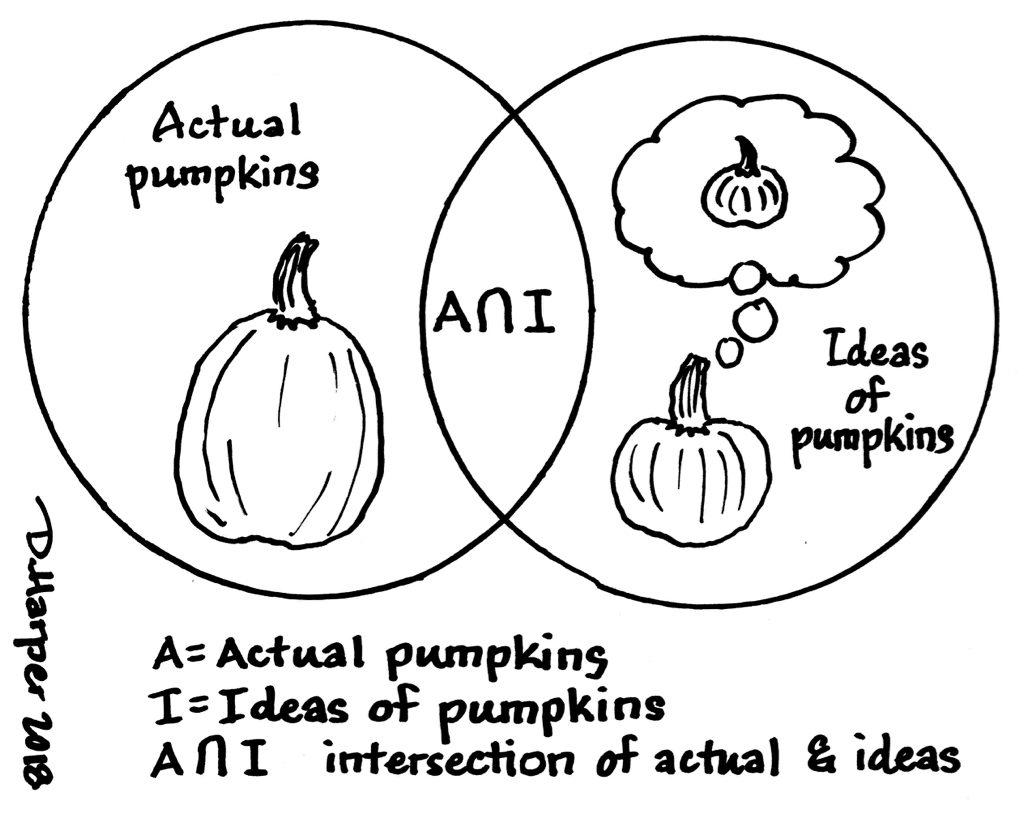
By the way, you will notice that this Venn diagram stayed on the page for the remainder of the time you were looking at this article. I have come to expect that sort of behavior from Venn diagrams, although to paraphrase Lord Berkeley’s question: If a Venn diagram is on the page, and no one sees it, does it stay on the page for the remainder of the article? The only reason I can indulge in such stupid sophomoric humor is that the authors of this article needed a remedial course in writing good prose.
Boomer challenges
Most of us who are Baby Boomers are all too aware of the major challenges facing our generation. (Some Boomers are insulated from these challenges, particularly among the socio-economic elites — but that’s always been true for most of the challenges facing humanity, and the elites constitute a small percentage of Boomers anyway, so we can ignore them.)
I’d like to look at three areas where we face major challenges: finances, jobs, and spiritual matters.
Financial challenges first. Back in the 1970s and 1980s, as part of the wave of economic conservatism that swept the United States, employer-managed pensions disappeared and were replaced with 401(k) plans. The Boomer generation, particularly the tail-end Boomers like me, are the ones who are the guinea pigs for this radical experiment in economics. And the experiment, to be quite frank, is going badly.
Younger generations, you will want to pay attention to what happens to the Boomers, because you’re stuck in the same flawed retirement system.
I’ve been reading Fifty-Five, Unemployed, and Faking Normal: Your Guide to a Better Retirement Life, a 2016 book by Elizabeth White that describes in some detail how badly off the Boomer generation is. Continue reading “Boomer challenges”
